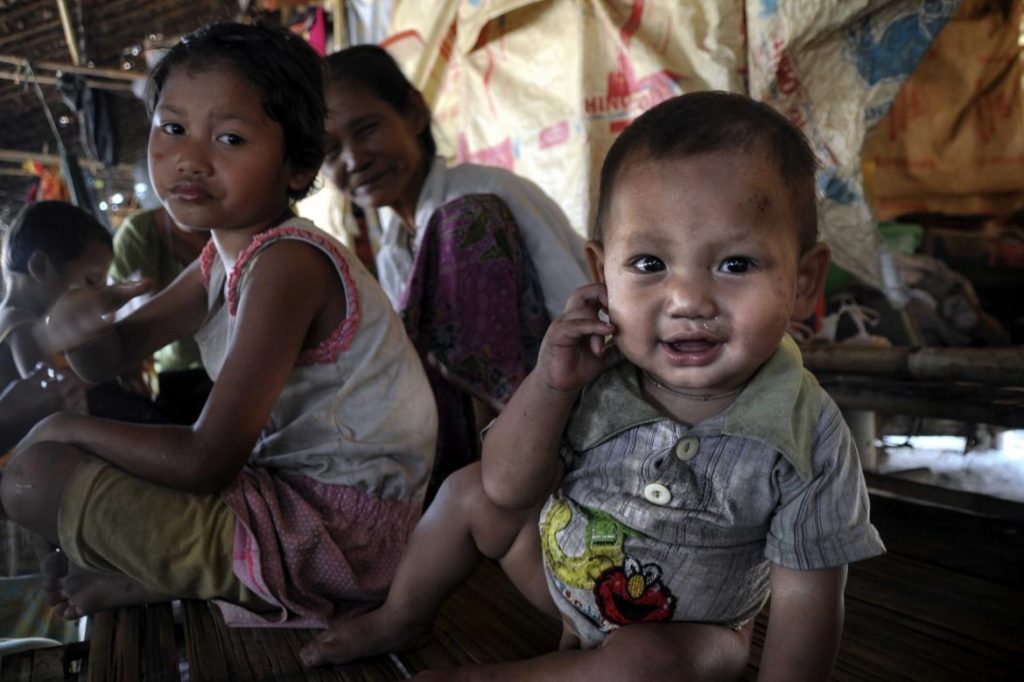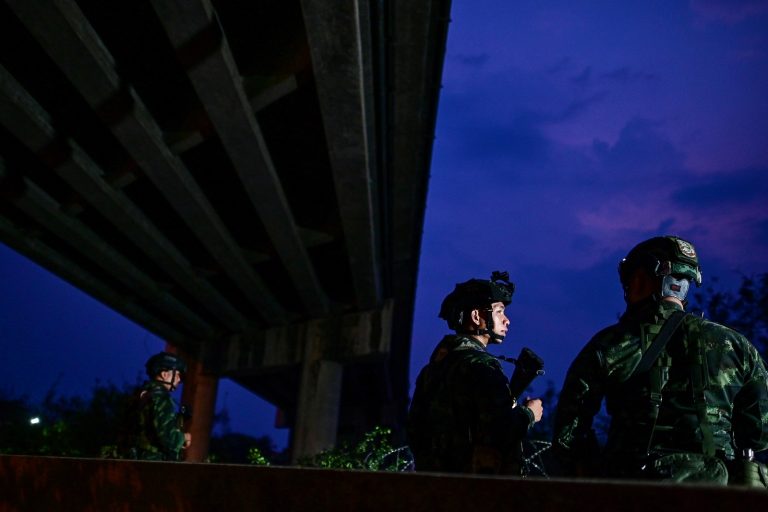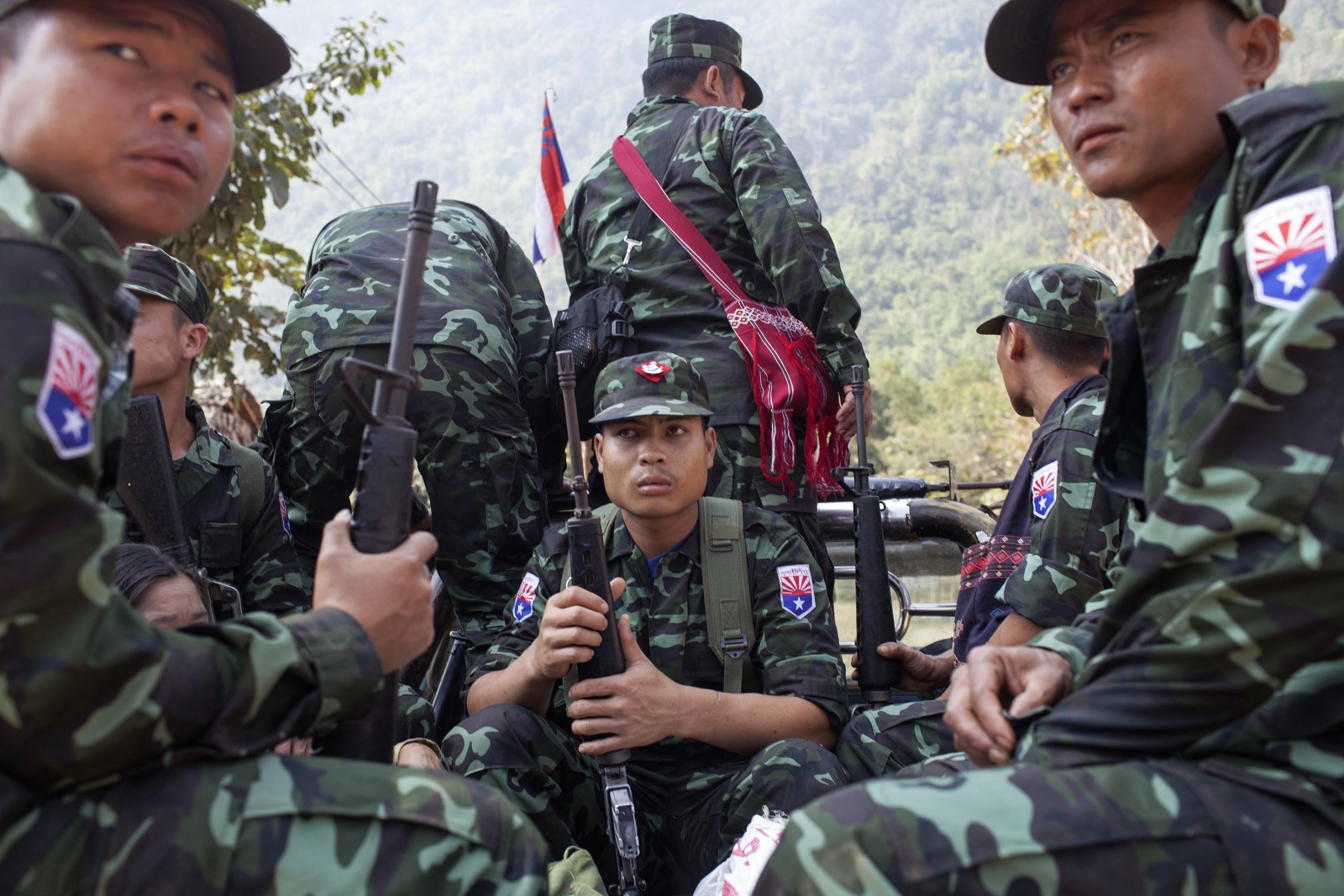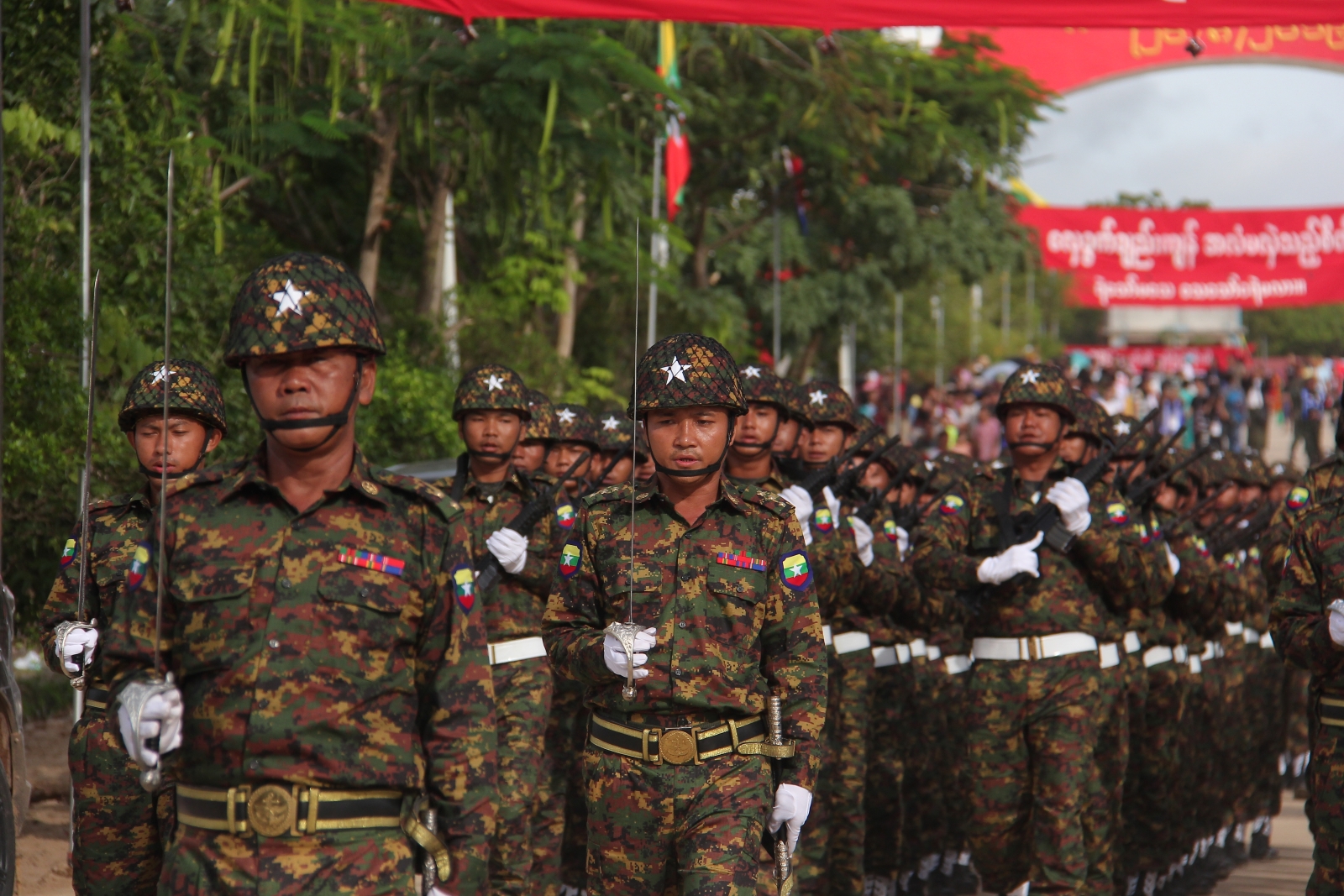While the people of Kayin State have largely benefited from the decision by three Karen armed groups to sign the Nationwide Ceasefire Agreement in 2015, conflict and religious tension remain a fact of life in the DKBA-controlled Myaing Gyi Ngu region.
Words & Photos KYAW LIN HTOON | FRONTIER
STAKEHOLDERS IN the peace process among the government and the Tatmadaw often cite the example of Kayin State in their efforts to encourage ethnic armed groups in other parts of the country to sign the Nationwide Ceasefire Agreement.
Three Karen groups were among the eight that signed the NCA in October 2015, a highlight of the peace process launched four years earlier by President U Thein Sein.
They included the Karen National Union – one of the biggest ethnic armed organisations, which had been fighting the government since soon after independence in 1948 – as well as the Democratic Karen Benevolent Army and the KNU/Karen National Liberation Army-Peace Council.
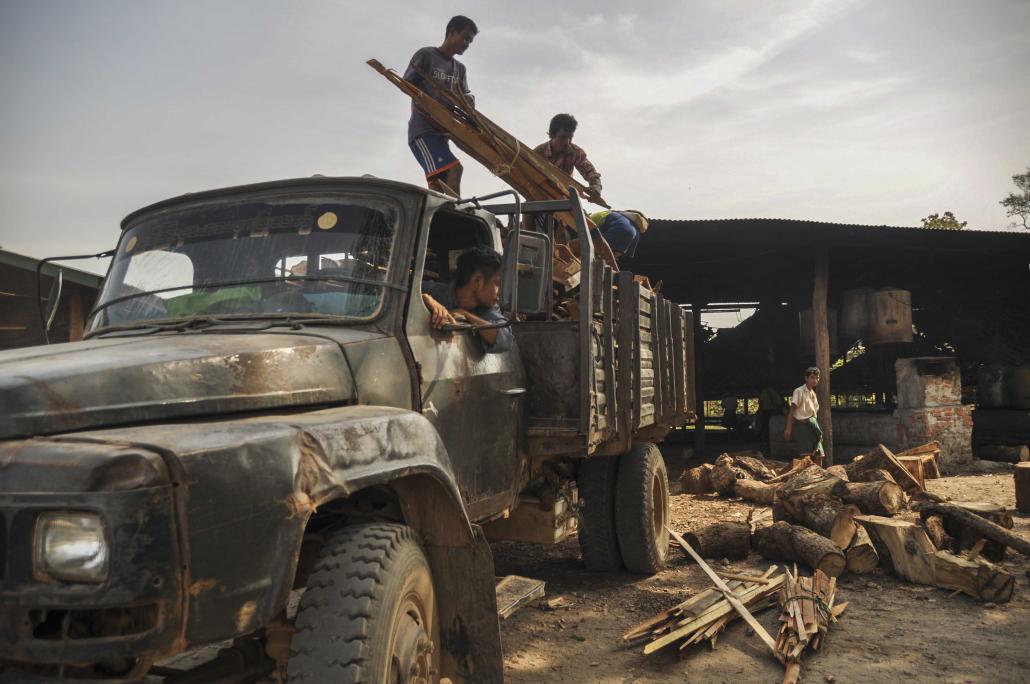
Residents of an IDP camp at Myaing Gyi Ngu return from working on a road construction project, their truck loaded with firewood to cook rice for camp residents. (Kyaw Lin Htoon | Frontier)
Support more independent journalism like this. Sign up to be a Frontier member.
Their decision to sign the NCA aroused keen interest among peace monitoring organisations, because they wanted to see if Kayin could be a role model for the process to bring lasting peace to Myanmar.
The country’s southeast is generally more peaceful than in the past, and certainly compares well to northern Myanmar, where fighting has increased since 2011. But implementation of the NCA, to which the New Mon State Party and the Lahu Democratic Union became signatories on February 13, has been far from smooth in Kayin State.
Analysts say the NCA, which stipulates the precise steps that signatories on both sides are required to follow to bring peace to their respective areas, has been troubled by delays.
They say initial steps affected by delays range from the resettlement of people displaced by conflict and de-mining to interim arrangements related to security affairs, the rule of law and measures towards DDR (disarmament, demobilization and reintegration).
“Both counterparts need to conduct all steps exactly as the NCA has prescribed,” said Saw Kyaw Swar, secretary of the Karen Affairs Committee.*
The Myaing Gyi Ngu war
In September 2016, fighting broke out around Mae Tha Waw between a splinter group of the Democratic Karen Benevolent Army led by Major Na Ma Kyar and a Border Guard Force comprising former DKBA soldiers backed by the Tatmadaw.
Thousands of villagers fled to Myaing Gyi Ngu, a large village on the east bank of the Than Lwin (Salween) River about 70 kilometres north of the Kayin State capital, Hpa-an.
The IDPs received support from U Thuzana, a controversial monk better known as the Myaing Gyi Ngu Sayadaw, but were soon put to work turning his vast monastery in Myaing Gyi Ngu into a pilgrimage destination.
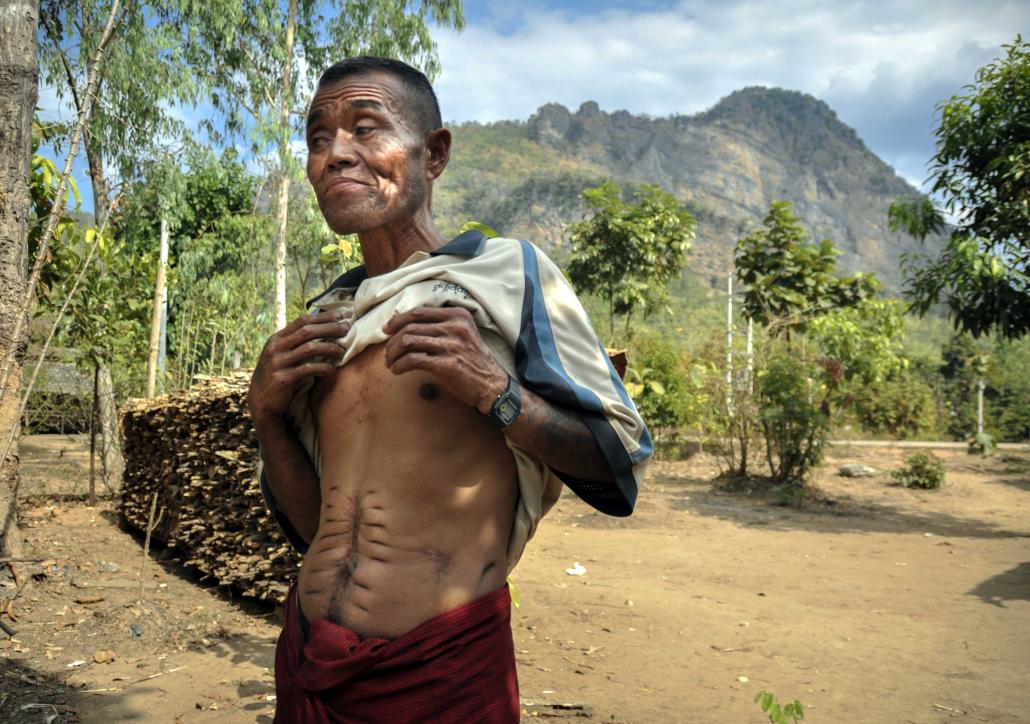
Saw Khay Mee, a DKBA veteran, holds up his shirt to reveal injuries he suffered while fighting for the KNU in the early 1990s. He is now head of a village for DKBA veterans and their families. (Kyaw Lin Htoon | Frontier)
His plan to attract visitors followed a state government development project that improved access to the area and contributed to better relations with the community after the signing of the NCA. The project included upgrades to the road between the Hlaingbwe-Hpa-an junction and the Kyone Htaw waterfall.
Local sources say Thuzana sent men from among the IDPs he was supporting to help with the roadwork.
The sources said boys, as well as men, were also required to help in building a dhamma yone (hall for religious purposes) at Thuzana’s monastery as well as a project to inscribe on stone a Kayin translation of the Pali Canon, known as the Tipitaka. The inscribed stones will be installed in the monastery compound and there’s hope it will also become a pilgrimage destination for Buddhists from Thailand. Frontier tried to interview the sayadaw on a recent visit but was told by a trustee of the monastery that he was visiting Bangkok for medical reasons.
The two IDP camps at Myaing Gyi Ngu house more than 4,000 people. Thuzana has arranged for them to be provided with steamed rice each day but all other food is their own responsibility.
“Mostly what we found is that they have to find other food by foraging for fruit and vegetables in nearby jungle,” said Saw Kyaw San Win, a former KNU information officer and the husband of Nan Thuzar Win, deputy speaker of the Kayin State Hluttaw and a member of the National League for Democracy.
Speaking to Frontier in a teashop outside the Kayin State Hluttaw, Kyaw San Win said youth groups sometimes visited the camps to donate food. “Then they take selfies and come back [to Hpa-an],” he said.
The Buddhist prohibition against killing has resulted in a ban on eating meat in the camps but not all of the IDPs have become vegetarians. Frontier observed meat dishes being prepared in some tents by women who said their husbands needed the nutrition it provided to have enough energy to toil on Thuzana’s projects.
The camps’ residents include hundreds of children, most of whom attend classes arranged and taught by teachers who fled with villagers to Myaing Gyi Ngu during the fighting two years ago.
The IDPs include Naw Tin Hla, 43, who has been assigned by the monastery to oversee the daily cooking of steamed rice.
The fighting was nothing new to Tin Hla, who as a Karen has known conflict for much of her life. At 14, she was forced to work as a porter, carrying equipment through the jungle for the Karen National Liberation Army, the armed wing of the KNU. She said she missed her village in the Mae Tha Waw area, where she had been raising her three children.
“We wanted to go back our own village at first but some villagers tried to return and were killed by landmines. So I dare not go back and others have the same fear,” she told Frontier.
Veterans’ camp
About 16 kilometres from Myaing Gyi Ngu is a village called Thitsar Aye Myaing that hosts more than 1,400 people, including retired DKBA soldiers and their relatives.
The village was created as a result of the Tatmadaw’s Border Guard Force policy. Prior to the 2010 election, the military proposed that all ethnic armed groups transform into BGFs that would be part of the Tatmadaw. Most groups resisted, but a few, including the Democratic Karen Buddhist Army (as it was then known) elected to become BGFs, and some of its soldiers were demobilised. (The DKBA’s brigade five refused and renamed itself the Democratic Karen Benevolent Army. It later signed the NCA.)
Saw Khay Mee, 54, a DKBA veteran and the chairman of Thitsar Aye Myaing, recalled his days in the KNU, the leadership of which is mainly Christian, before the split that led to the formation of the DKBA.
“I voluntarily joined the KNU at 18 because one of my brothers was already a member, but he was forcibly recruited,” Khay Mee told Frontier.
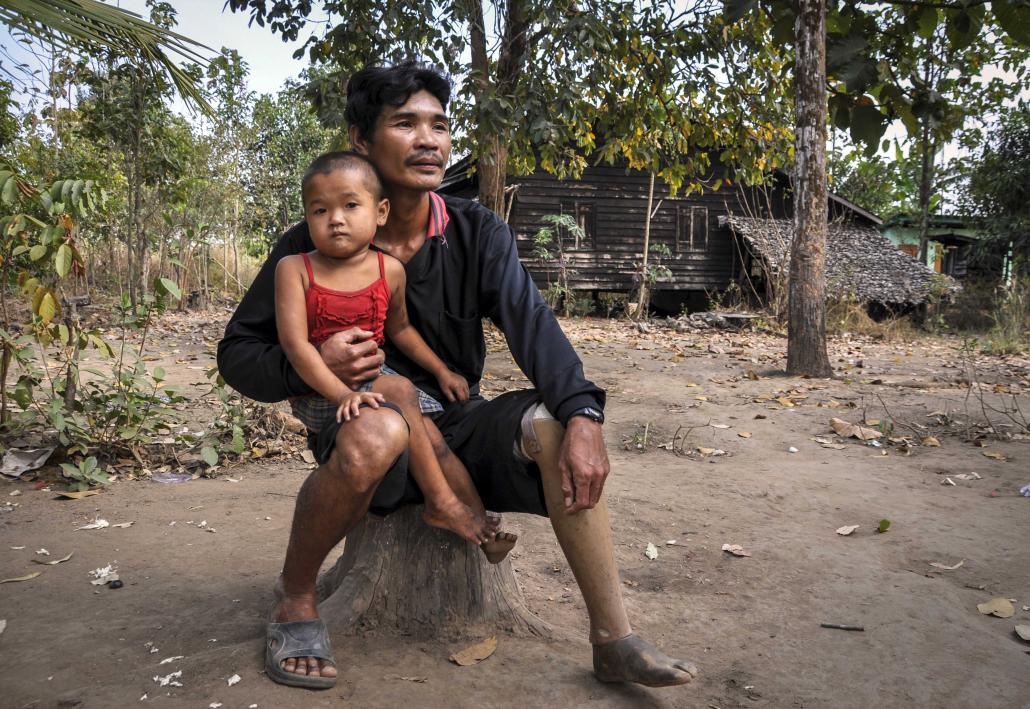
A disabled DKBA veteran holds his daughter at Thitsar Aye Myaing village near Myaing Gyi Ngu. (Kyaw Lin Htoon | Frontier)
He revealed big scars on his stomach caused by injuries suffered from one of the last skirmishes he fought as a member of the KNU before he joined the DKBA in 1994, when it was created. About 70 veterans in the village were disabled by war injuries.
U Soe Myint, 63, a Bamar, stands apart from other village residents. He and his wife followed their son from Kyaikto Township in Mon State in 2002, after he married at Myaing Gyi Ngu three months after arriving there to work at Thuzana’s hospital.
At the time, the hospital at nearby Lin Loon Myaing village was reserved for DKBA personnel. However, Thuzana’s close relationship with the DKBA resulted in a decision to transfer authority for managing the hospital to the monastery, and its responsibilities range from dealing with shortages of medicine to the water supply.
After Soe Myint and his wife settled at Thitsar Aye Myaing, they decided to help at the hospital. The decision meant that Soe Myint, who had never fired a weapon in his life, was made a kind of honorary DKBA veteran.
Thitsar Aye Myaing is more secluded than other villages in the Myaing Gyi Ngu area and in March and April it suffers from water shortages that sometimes affect residents for weeks.
During the previous Union Solidarity and Development Party government, the Kayin chief minister visited Thitsar Aye Myaing and instructed his staff to build a school and other infrastructure in the village.
Residents said the village was yet to receive high-level visitors since the National League for Democracy took office in March 2016, but they are content that, for the most part, the guns have fallen silent.
“I don’t feel proud to have been part of the ethnic revolution. I believe that I had this kind of life just because of my fortune,” Khay Mee said. “Nowadays, we just want the stability, peace, and development.”
Obstacles to peace
Although the peace process is showing signs of progress at the national level, such as the recent addition of more signatories to the NCA, the situation on the ground in areas where signatory groups operate is often precarious.
This is especially so in remote areas where there is little or no government administrative presence. One such community is Naung Ka Myaing village, about 32km (20 miles) northeast of Hpa-an.
On January 23, a combined group of Myanmar Police Force and BGF personnel raided a house of a KNU/KNLA-PC captain, triggering a firefight that lasted about 20 minutes. The skirmish ended with the arrest of the seven occupants in the house, who were accused of drug trafficking.
Naung Ka Myaing resident Saw Aung Thein, 60, a former staff member of the Karen Human Rights Group, denounced the raid.
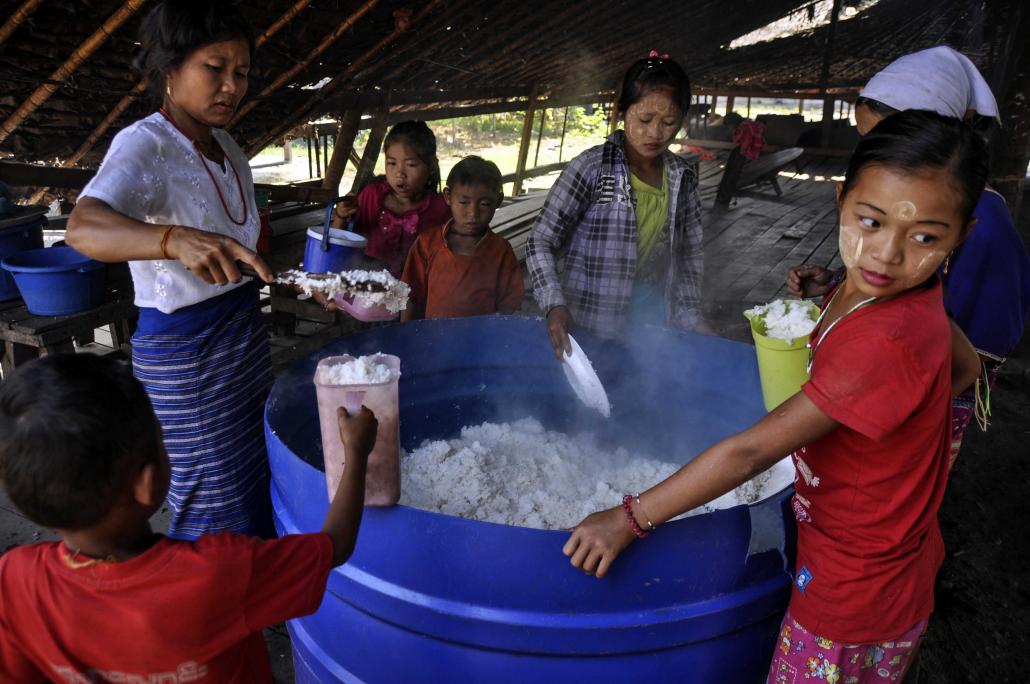
A woman distributes steamed rice to IDPs at Myaing Gyi Ngu. Because of the Buddhist prohibition on killing, residents are not supposed to eat meat, although this rule is not always observed in private. (Kyaw Lin Htoon | Frontier)
He welcomed efforts to suppress the drug trade in Kayin State, but added, “Even if the the ethnic armed group members were actually [trafficking drugs], the way that [the MPF and BGF] used to seize them was still not right.”
The firefight could have been avoided if high-level officials from both sides had instead talked to each other, Aung Thein said.
“They didn’t do that, instead they just chose the way of fighting that could frighten and threaten the local community,” he said.
A clause in the NCA commits its ethnic armed signatories to eradicating illicit drugs in their areas.
On the issue of IDPs, there will need to be talks between the government and ethnic armed groups to agree a policy that provides for their resettlement after a lasting peace agreement is reached.
The NCA also provided for the creation of state-level joint ceasefire monitoring committees to check for violations in the interim period before a peace agreement was signed but there have been challenges, said Kyaw Swar, the son of former KNU chairman General Tamla Baw, who died in 2014 aged 94.
He said most complaints to the JMC-S in Kayin concerned taxes levied by an armed group and added that this was happening because both sides had failed to make interim arrangements that would have provided clarity.
A third round of the 21st Century Panglong Union Peace Conference was supposed to take place in January but has been postponed indefinitely.
Kyaw Swar said that before the next meeting takes place, the issues that emerged at the previous conference last May need to be resolved.
If the peace process was to continue without completing each step, “We will not get the goal we all want.”
*Correction, March 22: An earlier version of this article incorrectly identified the Karen Affairs Committee as part of the KNU.
TOP PHOTO: Children at the IDP camp in Kayin State’s Myaing Gyi Ngu region. The camp was set up following clashes in September 2016 in nearby Mae Tha Waw. (Kyaw Lin Htoon | Frontier)


